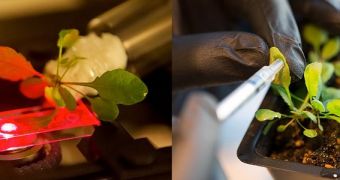Scientists with the Department of Chemical Engineering at the Massachusetts Institute of Technology (MIT) and the Department of Chemical Engineering at the California Institute of Technology (Caltech) have just published a new paper on an advanced method of improving photosynthesis in living plants. Unlike conventional approaches, the new one is based on the use of nanotechnology.
In essence, the team has just set the foundations for a new field of research, tentatively called plant nanobiotics. In their experiments, scientists were able to successfully inject single-walled carbon nanotubes (SWCNT) in chloroplasts, the plant organelles responsible for absorbing sunlight and converting it into chemical energy.
Ultimately, this chemical energy is used to synthesize glucose, which is the primary energy currency for plants. Over hundreds of millions of years, vegetation has evolved to conduct the most efficient type of photosynthesis available, but scientists say that the organelles responsible for this process are basically just very small machines. As such, it would not hurt to upgrade their efficiency artificially.
This type of experiments is nothing new, but what sets this research apart from all others is the fact that it was carried out in living organelles, not chloroplasts that had been previously removed from their host cells. The team reported a photosynthesis efficiency increase of up to 30 percent. This level is lower than what is obtained with free chloroplasts, but it still represents a very big step forward.
Details of the investigation were published in the March 17 issue of the top journal Nature Medicine, IEEE Spectrum reports.
Chloroplasts are able to absorb sunlight through a pigment called chlorophyll. The latter are molecules ranging in size from 400-500 nanometers to 600-700 nanometers. They are only able to absorb a small portion of incoming light, but adding SWCNT apparently increases this efficiency by allowing the pigment to absorb light in other ranges as well.
Chlorophyll usually captures infrared light, but the nanotubes allow it to capture near-infrared, optical, and ultraviolet wavelengths as well. If the flow of electrons is interpreted as a measurement of photosynthetic efficiency, then adding the SWCNT increases this flow by nearly 50 percent.
“Improving photosynthetic efficiency may require extending the range of solar light absorption, particularly in the near-infrared spectral range, which is able to penetrate deeper into living organisms,” the MIT team explains. Experts say that a delivery technique had to be developed in a separate experiment, to deliver the nanostructures into the living plant.
The end result is a method called lipid exchange envelope penetration (LEEP), which involves coating the nanotubes with negatively-charged DNA. This allows them to be absorbed through stomata, tiny pores on the undersides of leaves, when placed in a watery solution. In addition to increasing efficiency, the new method also contributes to keeping plants safe from overexposure to light.

 14 DAY TRIAL //
14 DAY TRIAL //